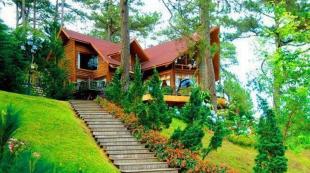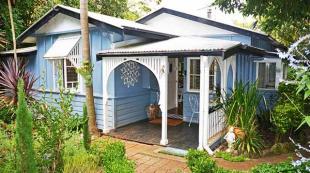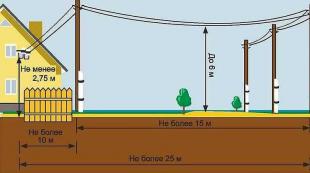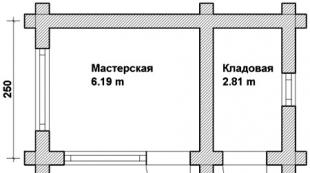Projects of houses on difficult terrain. Is it advisable to build houses on a slope?
Without a doubt, the ideal condition for building a country house is a flat plot, but this is not always the case - quite often country plots are located on the slope of a ravine or on the edge of a river descent. In such situations, building a house becomes somewhat more complicated, and there are many reasons for this, among which landslides and ground movements occupy a special place. In general, building a house on a slope is a little more difficult, and if you are faced with such a task, then you need to start solving it by studying basic information.
House on a hillside photo
House on a slope: advantages and disadvantages
Not everything is as scary as it might seem at first glance - at one point, building a house on a slope creates some difficulties, and at another, as they say, it makes solving some problems easier. It is for this reason that the first place to start studying the issue of constructing such buildings is to become familiar with their advantages and disadvantages. Let's start with the shortcomings - these include the following points.

And, of course, there are design difficulties - a house on a hillside does not have standard designs. You should understand that if you are faced with the decision to build a house on a slope, you will have to turn to builders who, for quite a lot of money, will develop a project that will take into account everything necessary to make your house warm, cozy and durable. Now regarding the advantages of a house on a steep slope. There are quite a few of them too.

Even watering areas with a house on a slope is an advantage - proper terracing of the slope will retain the right amount of water for vegetation to grow. In general, complete harmony - in the sense that the disadvantages of building a country house on a slope are almost completely compensated by the advantages.
How to build a house on a slope: the foundation is everything
The foundation of a house is a responsible structure that fully ensures the reliability and durability of the building - in the case of a house on a slope, this point is very relevant, and this stage of construction should be treated responsibly. Let's face it - not every type of foundation is suitable for such buildings. Of all the existing diversity, only three varieties are used.

To learn how to build the foundation of a house on a slope, watch this video.
In general, making a foundation for a house on a slope is a rather complicated matter, and it does not depend on the type of foundation chosen. Not only does it need to be correctly calculated taking into account local factors, but it also needs to be built correctly - in general, this is a matter exclusively for professionals.
Building a house on a slope: features of arranging a slope
A properly designed slope is another guarantee that the structure will stand for a long time and nothing will happen to it. Just don’t think that terraces will help you cope with the arrangement of the hill one hundred percent - yes, they play an important role, and level areas significantly reduce soil movement. But besides this step, you need to think about other possibilities that, together with the terraces, will serve to reliably strengthen the slope.

In general, it will be necessary to carry out a full range of measures aimed at solving issues such as strengthening the slope, preventing landslides and soil erosion.
And in conclusion to the topic of how to build a house on a slope, a few words about the signs that indicate that building a house on your site will require a lot of costs to strengthen the slope. These are natural phenomena - ravines, rickety trees, pillars and other similar things - they indicate a fairly large moving layer of soil, which can reach up to 3m. By the way, the moving layer of soil, or rather its thickness, is a direct indication of the depth of the foundation and the depth of the base of the retaining walls, through which the area is terraced on the slope.
In the first two articles, we talked about how terrain features influence the construction of a house and how best to place your building in the existing landscape of the site. Let’s complete the series of articles with a story about exactly how the direction of the terrain’s slope influences the choice of location for a house.
Location of the house on a plot with a southern or eastern slope
The southern slopes, of course, are warmed more by the sun. Therefore, you should try to orient your living quarters to the east, southeast or south. By locating the house on a southern slope, you can save resources on heating the building during the heating season. There is enough warmth on the south-eastern and eastern slopes. These directions are especially favorable for areas with cold climates. For warm areas, such slopes are good because it gets cool earlier. If you place the entrance to the house on the south side, then there will be less snow in the winter and it will melt faster in the spring. The southern slope receives less wind, and the sun warms up more, illuminating the rooms and the terrace. When implementing, for example, a project for a two-story house with a garage, it is worth placing it on the southern slope closer to the eastern border of the land allocation.

Location of the house on a plot with a northern slope
It is not recommended to place houses on northern slopes, unless we are talking about a site located in a hot climate. If it is necessary to determine a place for a house on the northern slope, then build it in the middle, as close as possible to its western border.

Location of the house on a site with a western slope
Western slopes are known for being very hot in the afternoon sun, so they are also not recommended for construction. This applies to all climatic regions. If there is a site for construction located on the western or eastern slopes, then the house should be located at its northern border at its highest point, placing all outbuildings below.

Pocket of cold
When placing a house on rough terrain, you should take into account the flow of cold air that descends at night. An obstacle in the form of a house wall that appears in his way contributes to the formation of a “frost pocket” or “cold pocket”, the temperature in which will be 9 degrees lower than the environment.

Winter Garden
If you plan to decorate the house with a winter garden, then it is ideal to attach it to the north side. In addition to its main purpose, this room will serve as a thermal buffer. In addition, you can avoid installing sun protection devices and not be afraid that the plants will be exposed to direct sunlight. It is better to orient the open part of the winter garden towards the slope.
Basic rules for locating a house on a relief site:
- It is worth ensuring a distance of at least 6 meters from the living rooms of the house to buildings on the neighboring site.
- If the size of the plot allows, it is worth removing premises for animals, toilets and compost pits at a distance of 15 meters from the house, placing them at the bottom of the slope.
- You can free up space for passage on the site by moving the house to the border of the territory (relevant for those who have chosen a two-story garage project).

Any uneven terrain complicates the preparatory work for construction:
- The house construction project must be developed individually, linking it to the existing conditions of the area.
- The project must take into account the location of the site and its slope.
- Before you start developing a project, you need to perform complex calculations.
- If you prefer to design a two-story house with a basement, you should pay special attention to the issue of insulating the building surfaces adjacent to the ground from the effects of groundwater.
- It may also be difficult to build terraces or excavate part of a slope to build a basement.
All these factors require additional financial investments. But in many cases, uneven terrain can inspire bold experiments to create a non-boring modern home. Proper organization of the site for construction and the location of the house and other buildings on the site, taking into account its characteristics, will make the site unique.
Many owners view a plot of land with difficult terrain as a punishment. But any disadvantage can easily be turned into an advantage. To do this, you do not need to call a grader for leveling. A competently used height difference will demonstrate all the charm of a non-standard landscape. Of course, construction on a relief site, as well as its arrangement, will be fraught with difficulties. But the end result will give you satisfaction with the work done and will arouse the envy of your neighbors. This article will discuss the correct arrangement of a site with a slope.
Linking a house to a plot with a slope
There are 2 ways to link a building to a site with a slope - without changing and with changing the existing landscape. A typical project is developed on the basis that construction will be carried out on a level site.

A house being built in an area with natural conditions requires processing of the underground and basement parts. Thus, the housing will have characteristic features that correspond to the site.
The slopes of the site are divided into:
- on flatlands, where the slope is up to 3%;
- with a small slope (up to 8%);
- with an average slope (up to 20%);
- steep (over 20%).
On slopes it is not only difficult to construct buildings, but also to construct access roads. Retaining walls, embankments and other strengthening structures are installed on slopes with height differences of 1:2.
Project of a site with a slope

Vertical layout of a site with a slope
Work on arranging a landscape with a complex “character” includes:
- leveling the terrain as much as possible by removing soil in one place and adding it in another;
- organization of storm drains, which can be either hidden or open;
- determining the optimal location of the main house, gazebo, summer shower, vegetable garden, garden trees;
- correction of small irregularities using the terracing method; for steep drops - arrangement of retaining walls.

- This approach will help not only to correctly divide the territory into functional zones, but also makes it possible to design it in an original way.
Drainage system on a sloped area
- The organization of the drainage system should be given due attention. Drainage will allow you to regulate the water balance and ensure rapid removal of water formed after precipitation or melting snow.
- Rain and melt water form gullies. And the steeper the height difference, the greater the likelihood of slope failure. Since even small streams can create large ravines and lead to landslides of soil masses.
- The drainage arrangement begins after all the main excavation works and communications have been laid. Knowing at least the approximate location of the main buildings and green plantings will help to correctly install the drainage system.
- The installation method can be open or closed. The main advantage of a hidden drainage system is space saving. Since the canals run underground, access roads and paths can be built on top of them.
- Trenches are dug along the slope of the entire site to the receiving collector. What is more effective is the installation of drainage in a herringbone pattern, where additional outlets are adjacent to the main line at an acute angle. With this method, the central trench should be located just below the auxiliary channels.

- The depth of the trenches can range from 30 cm to 1 meter. The slope should not be less than 2 mm per linear meter of length. This parameter is important even in areas with a slope, because part of the system can also pass on a flat area.
- A 10 cm layer of sand is poured into the bottom of the trench and compacted. Geotextiles are laid on top of it, the edges of which should cover the channel walls with a margin. Next, crushed stone is poured with a layer thickness of 10-20 cm.
- Perforated polymer pipes are laid on the gravel bed and connected. The pipes are covered with a layer of crushed stone, and the finished system is covered with geotextiles. The entire “pie” is covered with sand and soil.
Design of a site with a slope
Mastering a complex landscape is fraught with certain difficulties. But this should not be an obstacle. A competent approach to landscaping work will lead to enchanting results.
Plot with a slope photo

- Elevation differences make it possible to realize the most daring, original ideas. Alpine design is best suited for these purposes. The highlight of this style is the use of rough-hewn stones and a large number of delicate and bright colors. With the help of these 2 elements, the maximum number of tasks is solved:
- zoning of the site is carried out;
- boulders and plants serve to strengthen the slopes;
- promote snow retention;
- perfectly decorate the entire space.
- Planting green spaces should be carried out based on the rule - the lower the point, the taller the plants. That is, low-growing varieties are planted on the upper part of the slope, and shrubs and trees are planted in the lowlands. This placement will help visually level the terrain.

- The entire area of the site must be planted. Between the beds and fruit trees, a lawn or ground cover plants (ivy, barberry, Japanese quince) are planted in empty areas. In addition to the aesthetic component, they will protect the soil from washing out.
- In hilly areas it is impossible to do without paths and stairs. They should be as comfortable as possible, since you will have to move around them more than once during the day. It is recommended to make the width of the paths and the height of the steps of the stairs the same throughout the entire territory; this approach will help to avoid injuries.
- Paths are laid out on a relatively flat surface. To visually smooth out the difference in heights, they are made tortuous.
- Stairs and steps are necessary on steep slopes. If the slope is very large, then railings are installed on at least one side. The optimal tread width is 25-30 cm, the riser height is 15 cm. The slope of the entire structure should not exceed 45°.
- If the flight of stairs is long, then rest areas are built, from which you can change the direction of ascent. The presence of more than 10 steps requires a concrete base, which will provide stability and prevent “sliding” of the entire staircase.
- Terracing will help to properly arrange a site with slopes. The size and shape of the platforms is based on their purpose, so one width is needed for a vegetable garden, and another for a gazebo with a barbecue.
- Zoning of the site is carried out taking into account its location relative to the cardinal points. Shading is also taken into account; shade-loving plants are planted in such places; a bench for reading can be installed.
- When planning, it should be remembered that the more terraces are organized on the territory, the lower the height of the fortification walls. Accordingly, their construction is easier. Each terrace should ideally be equipped with its own drainage system.
Slope strengthening
Preventing the sliding of a loose mass of rocks is carried out by carrying out various fortification structures. The method of fixing the soil depends on the steepness of the terrain.
- Natural strengthening. For relatively gentle slopes (up to 30°), creeping plants are used to form a decorative cover. Branched roots will create a natural frame. Willow, lilac, and rose hips are planted in the lowlands. Over time, the developing roots of the shrubs will also reliably hold the soil together.
- Geomaterial. An excellent solution would be geotextiles or geogrids. The material is spread on the site and covered with soil. After a while, the soil will twitch and turn green. Such strengthening does not imply a change in terrain. The protective layer covering the material is resistant to adverse weather conditions and chemical influences. The service life of the product is 50 years.

- embankment. Consolidation measures can be carried out using an embankment. But when implementing them, it should be remembered that the embankment occupies a usable area, so it is rational to use it in spacious areas. Another disadvantage is regular topping, that is, after a certain period of time, soil is removed from the base and added to the top of the slope.
- Retaining walls. Walls made of natural materials (stone, wood) look advantageous and practical. The fortification structure will protect the slope from destruction and delimit the space through terracing. They can be installed on hilly terrain with any elevation changes.
- Low walls (up to 80 cm), which play more of a decorative role than a functional one, are equipped on their own. The construction of a massive structure, designed to largely prevent landslides of soil masses, should be entrusted to professionals.
- Gabions. Modular structures are widely used by landscape designers. Gabions are easy to install; they are filled with pebbles, coarse crushed stone, and rubble stone. You can fill the voids between the material with earth, and then in the spring, the unaesthetic mesh with cobblestones will disappear behind green growth. Modules are purchased from the manufacturer or made from wire yourself. Stone walls with sprouts sprouting give the area a noble, visually aged appearance.

- When designing reinforcement structures, the forces acting on overturning and shearing are calculated. Strength and durability are imparted to the walls through a foundation, the thickness and depth of which depends on the height of the supporting wall, its purpose and the type of soil.
- The supporting part of the wall resists vertical loads. The presence of a drainage system during the construction of walls is mandatory. It will prevent rain and melt water from washing away the base of the wall.
- The most commonly used material for building walls is stone. Artificial or natural boulders can be laid either with or without mortar. With the “dry” masonry method, soil is laid in the voids and sown with seeds. Unfortunately, the lack of mortar makes the wall not a particularly reliable structure during prolonged rains and during spring floods.

- Brick is also particularly popular. The clinker masonry may be loose or dull. The material allows you to build walls of any configuration, winding and zigzag shapes.
- Wooden elements fit harmoniously into the surrounding landscape, but due to their special characteristics, their use as a fortification structure is not advisable. Of course, treatment with special preparations will extend the life of the wood, but again, this is only temporary protection. This design requires regular maintenance.
- If, when constructing walls made of stone and brick, the height of the structure should not exceed 70 cm, then the use of concrete allows a similar figure of 3 m. Here you can use concrete slabs made in a factory, or pour the concrete mixture into the prepared formwork.
In conclusion, I would like to summarize some results:
- a plot of land with difficult terrain will be cheaper, but the costs of its development will be noticeably higher than on a flat area. Conclusion: no savings;
- extensive work on tying a residential building to the topography, the location of recreation areas and beds are fully compensated by the overall original appearance of the site. Conclusion: the difference in heights provides more opportunities to implement non-standard ideas than flat terrain.
It is not difficult to build a foundation on a flat area with modern technology. However, sometimes sites for future construction are located on steep slopes. Houses located on sloping surfaces have their advantages: they are better protected from wind and flooding, and are more affordable. In addition, the mountain usually offers impressive views. But under the influence of heavy precipitation and soil water, the soil gradually softens.
In the future, this can lead to a shift in the upper layers of the soil. To protect yourself from unpleasant consequences, you should choose and build the foundation correctly. This article will tell you how to do this.


Peculiarities
Building a foundation for a house on a slope is a difficult process that requires a special approach and adherence to technology, because the foundation is the main component of every building. For a sloping surface, a strip, pile or stepped base is usually chosen.
First you need to calculate the angle of inclination, measured as a percentage. If the slope is around the 10 percent mark, this indicates a high slope. The steeper the slope, the more effort and materials may be required. If the angle of inclination does not exceed eight percent, then the foothill part can be covered with soil. If the angle is more than eight percent, then you will have to build a basement.
It is worth remembering that the foundation on a site with a slope cannot be higher than four times its width. Before construction, the site must be divided into squares and landslide measures must be taken on each of them.
Kinds
Strip foundation is one of the most popular designs today. However, experts advise building this type of foundation only on slopes with a minimum slope. It is also worth considering various contraindications for surveyors.
The strip foundation is a closed contour of reinforced concrete beams and is laid under both external and internal walls, if necessary. This type is ideal for structures with heavy floors, as well as if plans include creating a basement. There are two types of strip base: monolithic and prefabricated.
A pile foundation is a durable structure made of piles that are buried in the ground and connected at the top by supports. Many experts agree that pile foundations are the best for erecting load-bearing structures on slopes. This is an effective and practical option for arranging a foundation at any depth.
The installation process is simple, although it requires special equipment. In addition, this type is cost-effective compared to other options. Piles can be made of wood, reinforced concrete or metal. Heaving soils (clay, loam, sandy loam) have special requirements. Here a pile foundation is also appropriate.
 Tape
Tape
 Pile
Pile
The columnar type is also suitable for constructing a foundation on a slope. It involves the erection of pillars in all corners. However, you need to take into account some nuances when constructing it: each pillar must be supported by a supporting wall, which enhances the stability of the foundation. The columnar version is economical and reliable and does not require additional waterproofing. But it is applicable only for wooden or frame houses.
The stepped foundation has a cascade arrangement in the form of ledges. It is suitable for slopes with great steepness, if surface leveling cannot be done for some reason. The general slope of this option fully corresponds to the natural slope of the site. Laying a stepped foundation looks like a classic concrete strip, constructed from steps of different heights.
A slab foundation with a difference in height on a site with a slope is the optimal solution for the construction of houses and cottages made of brick, aerated concrete and other materials. This base option provides reliable support for low-rise buildings and is particularly durable.
 Columnar
Columnar
 Stepped
Stepped
 Slab
Slab
When constructing a slab foundation, a continuous foundation of monolithic reinforced concrete is created at a small depth. The weight of the walls and roof is distributed evenly over the entire surface of the base. This design will be able to withstand any ground movement. The disadvantage of a slab foundation is the high costs of installation and materials.
How to choose a project?
When deciding which foundation is more suitable for a basement on an uneven area, it is necessary to determine the level of elevation difference, as well as conduct a study of the type of soil in the area. Poorly thought out construction on a slope can ultimately result in a ground collapse. It is better to invite specialists to calculate the necessary calculations.
If the angle of inclination:
- less than 3% is a flat surface;
- from 3% to 8% – low slope;
- up to 20% – average slope;
- more than 20% – steep slope.


In the first two options, it is possible to construct a strip foundation. If it is impossible to level the surface or the angle of inclination increases, a tape-step type is erected. For large slopes, only a columnar base is suitable. But a pile foundation is suitable for any slopes.
As for the type of soil, it is divided into:
- gristly - durable soil made of sand, clay and crushed stone;
- sandy – easily allows moisture to pass through;
- rocky - the most durable, but does not allow moisture to pass through;
- clayey – easily swells and freezes.


The more moisture in the soil, the more it swells when it freezes, pushing the foundation out of the soil. Therefore, in difficult soils, the base is placed below the freezing level.
When building a strip foundation, one part of the base is immersed deep into the slope. Setting up such a foundation is a costly undertaking, but if you are planning to build a brick or concrete house, then the strip option will be the best choice.
A pile foundation can be used for the construction of any type of building, be it a residential building, a garage or a bathhouse, as well as at any angle of inclination. With this option for constructing the foundation, it can be used for any purpose. The only drawback of the pile type is the impossibility of building a house with a basement.


Also, the choice of foundation type depends on whether you want to use the basement for a basement, wine cellar, living room or garage to save space. Don't forget about retaining structures. They help prevent landslide processes when it is impossible to change the surface topography. Such structures for different types of foundations on uneven surfaces can be presented in the form of support slabs and beams, pile structures and pillars, buttresses and fillings, rims and facing walls.


How to do it?
To properly install the foundation with your own hands, you must adhere to a certain technological sequence. If you want to build a house from concrete or brick, choosing a strip foundation would be an ideal option. A monolithic strip foundation does not require long construction times. In addition, the construction of a strip foundation on an uneven surface is not very different from the construction of similar buildings on flat ground.
The bottom of the pit must be strictly horizontal. Before pouring, a cushion of concrete or sand is placed on the bottom. It is necessary in order to reduce pressure on the ground. Before lining, formwork is installed, rising above the ground level to a height equal to the parameters of the basement floor. Moreover, on the sloping part of the site the formwork will be of greater height. Next, the reinforcement is laid inside the foundation. Then you need to pour the concrete.
It must be poured continuously in layers of 20 cm. In this case, it is important to correctly calculate in advance the volume of concrete that will be needed during installation.


A column foundation is suitable for light private houses. It can be made of monolithic reinforced concrete or factory-produced concrete blocks. It is recommended to follow certain step-by-step instructions.
- To begin with, a retaining wall is erected at the top of the site.
- Next, according to the same scheme, a retaining wall is erected in the lower part.
- Soil is poured between the support strips with layer-by-layer compaction. This will allow the upper platform to contain the collapse of the soil.
- Along the perimeter of the house, holes are made, the dimensions of which must correspond to the parameters of the pillars.
- The foundation is made in pits. In this case, the edges of individual pillars must be carefully aligned in height.
- The grillage is made along the edge of the house foundation.


Pile foundation, which is the most economical, is suitable for steep slopes and unstable soils. The piles are screwed into the ground in such a way that their heads are at the same level. The process also consists of several stages.
- At the top point, a pile is buried, the visible part of which is equal to the height of the base along the smaller dimension.
- Next, the next corner pile is installed, the length of the visible part of which is equal to the length of the base in the larger designation.
- Then all pile elements are installed so that the top point of each is horizontal.
- The pile foundation can be strengthened using reinforced concrete clips, which are installed along the entire length of the piles.


From the point of view of architecture and landscape design, advantages can be found in a site on a slope. The relief allows you to realize the most original projects.
Your site will be the ideal place to organize your own small waterfall or fountain. However, the construction of buildings on sites with height differences has its own characteristics, which we will discuss in this article.
Houses on a slope: features of project development and site preparation
Let's figure out what the main difficulties exist when building houses on a slope:
1) Firstly, this is the likelihood of soil collapse. Moreover, the steeper the slope, the higher the likelihood of soil moving under the weight of the building. In this regard, additional means for strengthening the soil may be required. Before construction begins, an analysis of the soil layer must be carried out. What slope are you dealing with (landslide or not), its layout and history, groundwater depth, soil type, etc. A geologist will tell you. The layout of the building, as well as the soil stabilization technology, is carried out by a competent design engineer.
2) Secondly, the lack of standard designs for houses on a slope and the need to develop a new unique project. The higher the slope, the more difficult it is to carry out calculations and the more expensive the finished project will be for you.


3) Next, prepare the construction site. Again, additional costs will be required for the redistribution and strengthening of the soil, the organization of access roads to the construction site and the delivery of building materials.
4) Difficulties in constructing the foundation and its waterproofing, since moisture flowing from the slope can have a destructive effect (the danger of erosion by surface water should not be ruled out).
5) Along with designing the house, it is also advisable to plan the entire building.
6) Careful monitoring of excavation and construction works using optical monitoring devices will be required.


Construction technology depending on the angle of inclination and soil type
Depending on the degree of inclination of the site, we can distinguish the following construction work concepts:
- Until 3 %. Such sites are considered straight and houses on them can be built according to standard designs. The only additional condition is the organization of special channels through which sedimentary liquid will be drained. Most often, soil bedding is used for this purpose, decreasing in direction from the house.
- From 3 to 7%. Houses on a slope with a slope of up to 7% are only in very rare cases equipped with basements, and on the side of the slope itself they are often additionally backfilled and strengthened in order to subsequently avoid landslides due to the pressure that the building creates.
- From 8 to 10%. The most appropriate solution for such buildings are basement floors. They cut into the earth mass, and there is no need to level the main construction site. This option is especially convenient if convenient access can be arranged to the first floor. Then instead of a “basement” you can equip a garage. In this case, the place of contact with the ground of the walls and foundation is carefully waterproofed. It is worth considering that such construction will be quite expensive.
- From 10% to 20% and above. The site is considered difficult to develop. Most often, the slope is divided into separate levels (terraces), at each of which it is necessary to carry out anti-landslide work and strengthen the soil. The house is designed to be multi-level. Increase in construction costs above 50%.
 fountain on a sloped plot
fountain on a sloped plot  construction of a platform and foundation on a slope
construction of a platform and foundation on a slope
What other points should you pay attention to when building a house on a slope? From a placement point of view, the uppermost part of the site would be preferable. This will ensure the natural outflow of water from the slope. Provided that neighboring areas are located higher up the slope, it is necessary to provide for water drainage in advance. A site with a southern slope is preferable to other options, since the sunny side has a positive effect on the soil temperature, and also provides good natural light and microclimate in the built house, and you can save energy on heating.
Read more about heating with a double-circuit electric heating boiler in our next article.
The foundation plays an important role when building a house on a slope. A competent choice of foundation type will ensure the reliability and durability of the building. It is not recommended to rely on personal knowledge or advice from users on the Internet in such an important matter.
Thus, we can conclude that building houses on a slope is a feasible task, but will require significant financial costs from the owner. Therefore, before purchasing a cheaper plot with a difference in elevation, it makes sense to consult with a specialist about the possible costs of building housing in such an area. It may well turn out that the estimated construction costs will be many times greater than the savings when purchasing land.









